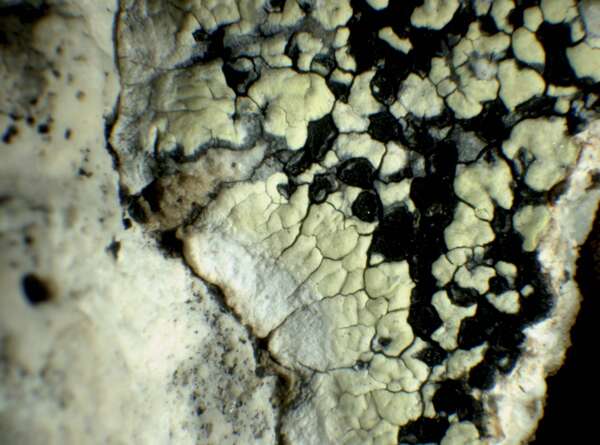Rhizocarpon atroflavescens Lynge
Lich. Novaya Zemlya: 141, 1928.
Synonyms: Rhizocarpon atroflavescens subsp. pulverulentum (Schaer.) Runemark; Rhizocarpon chiastomerum Lettau; Rhizocarpon geographicum var. contiguum f. calcicolum Anzi; Rhizocarpon pulverulentum (Schaer.) Räsänen
Distribution: N - Ven (Nascimbene & al. 2021), TAA, Lomb, Piem, Emil (Tretiach & al. 2008, Fariselli & al. 2020), Lig. C - Tosc, Abr (Nimis & Tretiach 1999, Gheza & al. 2021), Sar (Rizzi & al. 2011).
Description: Thallus crustose, episubstratic, rimose-areolate, yellowish white to white, farinose, forming patches to 2-5 cm in diam., delimited by a white to greyish prothallus. Areoles contiguous, forming a more or less continuous crust, 0.3-1.5 mm wide, irregularly subdivided by numerous cracks, more or less flat. Cortex without distinct structure, 40-75 µm thick; medulla white, I+ deep blue. Apothecia frequent, lecideine, but sometimes appearing almost lecanorine, being often surrounded by the areoles, arising between the areoles, rounded, 0.3-1.5 mm across, with a black, slightly concave to flat, epruinose disc, and a very thin, sometimes finally excluded proper margin. Proper exciple brownish red, K+ reddish-violet; epithecium reddish brown, K+ red; hymenium colourless, 90-150 µm high; paraphysoids strongly conglutinate, richly branched and anastomosing, clavate at apices; hypothecium brown, 100-300 µm high, K-. Asci 8-spored, clavate, fissitunicate, with a well-developed tholus, lacking an ocular chamber, Rhizocarpon-type. Ascospores 1-4-septate, rarely submuriform and with a single transverse septum, soon becoming dark green to brown, ellipsoid, 10-24 x 6-10 µm, halonate. Photobiont chlorococcoid. Spot tests: medulla K-, C-, KC-, P- or P+ yellow. Chemistry: cortex with rhizocarpic acid; medulla with psoromic acid.Note: a cool-temperate to arctic-alpine, perhaps circumpolar species found on steeply inclined surfaces of base-rich, or weakly calciferous siliceous rocks near or above treeline; common and certainly more widespread in the Alps, rare in the Apennines; the record from Abruzzo is the southernmost one in Europe.
Growth form: Crustose
Substrata: rocks
Photobiont: green algae other than Trentepohlia
Reproductive strategy: mainly sexual
paras Pertusaria
Commonnes-rarity: (info)
Alpine belt: rather common
Subalpine belt: rather rare
Oromediterranean belt: rare
Montane belt: absent
Submediterranean belt: absent
Padanian area: absent
Humid submediterranean belt: absent
Humid mediterranean belt: absent
Dry mediterranean belt: absent

Predictive model
Herbarium samples
Growth form: Crustose
Substrata: rocks
Photobiont: green algae other than Trentepohlia
Reproductive strategy: mainly sexual
paras Pertusaria
Commonnes-rarity: (info)
Alpine belt: rather common
Subalpine belt: rather rare
Oromediterranean belt: rare
Montane belt: absent
Submediterranean belt: absent
Padanian area: absent
Humid submediterranean belt: absent
Humid mediterranean belt: absent
Dry mediterranean belt: absent

Predictive model
| Herbarium samples |
 Index Fungorum
Index Fungorum
 GBIF
GBIF




